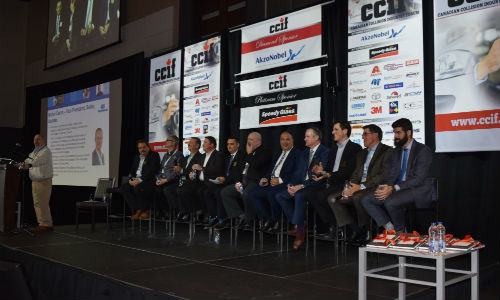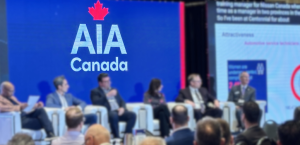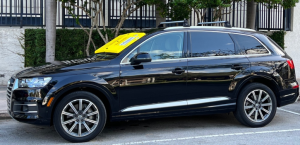By Mike Davey
Vaughan, Ontario — January 29, 2017 — “Possible injury or even death.” Those are among the possible consequences of not scanning and performing the correct calibrations during the repair process, according to Scott Wideman of Volkswagen Canada. Wideman made the comment during a panel discussion at the first CCIF meeting of 2017. The meeting took place at Universal Event Space in Vaughan, Ontario.
It was a perspective that seemed to be shared by the other OEM representatives on the panel. When asked a similar question by moderator Mike Anderson of Collision Advice, Paul Stella of Toyota noted that the consequences of allowing a vehicle to leave the shop without properly calibrating various systems could be “Serious injury. Or worse.”
Anderson led the panel on pre- and post-repair scanning and calibration. The panelists represented many of the major sectors involved in the business of collision repair. The OEMs were represented by Paul Stella of Toyota Canada, Chris Hogg of Honda Canada, Scott Wideman of Volkswagen Group Canada and Bruce Woodrich of FCA Canada. The insurance side was represented by Joe Carvalho of Economical, David Wedlake of Intact Insurance and Tony Sutera Sardo for RSA Canada. Representing the software side were Michel Caron of Audatex Canada, Michel Gagnon of Mitchell and Dan Young of Collision Diagnostic Services (CDS), makers of the AsTech scan tool.
In fact, the segment with the least representation was collision repair itself, with just one representative: Terrence Bradimore of CK Collision.
Anderson told the assembled crowd that he had approached six repairers to participate. While some bowed out to due to fear of public speaking, others indicated that they “feared insurance company retribution,” according to Anderson.
It’s easy to sympathize with this attitude, but the fears may be unfounded. By and large, the insurers on the panel seemed to agree that the modern repair process requires scanning and may require that systems be recalibrated. In general, they simply want to have the correct documentation to explain what was done and why it was needed.
“They want to pay what’s fair and reasonable,” said Anderson. “I’ve seen some shops in New York that are taking advantage of this situation and gouging the insurance company, and that’s wrong.”
The insurers on the panel indicated that policies were still being developed, but Sutera Sardo of RSA outlined what may be the best way forward for repairers at this juncture: document everything.
“My thoughts are that to properly repair the vehicle, we need to scan the vehicle,” he said. “We still find that the files are not well-documented. It’s important to build the file properly. Explain what came up: you scanned the vehicle and it gave you some fault codes. Often what we find is that we have the price, but not the explanation. We need that.”
Anderson reinforced this need to document and verify the procedures.
“There are well over a million claims in Canada every year. Let’s say the cost is $100 per car. That’s $100 million dollars,” said Anderson. “We all know that there are shops that will not do it, but still charge for it. How do we verify?”
There are at least three different liability issues at play here. First, there is obvious liability on the shops if they let potentially unsafe cars back onto the road. Second, there is a similar situation for insurers if they refuse to pay for operations that turned out to be necessary for a safe repair. The third issue is less obvious but ties into the idea of documenting and proving that the scans were needed.
Anderson started the panel discussion by sharing some anecdotes about various vehicles he had personally witnessed. One in particular ties into the liability issues that arise when it comes to sharing data. Anderson told the story of an Audi Q7 that needed work on its bumper cover. However, the customer also stated something like “my navigation system hasn’t worked since the accident.” The shop duly looked into the issue. After a thorough scan, they determined that the navigation system had gone offline a full seven months before the accident. The shop shared this data with the insurer to inform them that the navigation system was not damaged in the collision and should not be covered under the repair. The customer then sued the shop on the basis that the repairer did not have permission to share that data.
The point of all this is that it’s necessary for the shop to obtain authorization to share any data they recover from a vehicle. Anderson and Dan Young of CDS noted that AsTech has a sample authorization form on the company’s website that can be used for this purpose.
This is a concern for all involved parties. As Intact’s Wedlake noted, “We’ve had discussions at the national level regarding authorization. Who owns that data? There are still a lot of moving parts to this that we all need to understand.”
The panel also discussed the difference between OEM and aftermarket scan tools. The bullet point from the OEMs on this is essentially the same: they know their scan tools work on all of their vehicles and have the correct build data. They cannot say if aftermarket scan tools can do the same thing.
Dan Young of CDS noted that while the AsTech scanner uses 100 percent OEM tools on every test, the company owns a lot of aftermarket scanners as well.
“They’re in our R&D lab. We’re constantly monitoring the difference between the two,” said Young. Following up, Anderson asked Young how much the company spent on scan tools. “It’s significant,” he said. “The top of the line, in terms of costs, is about $10,000. We’re probably on a run rate of close to a million dollars by the time we get into next year.”
CDS has a wealth of real world scanning data to draw on, so naturally Anderson asked Young what percentage of pre-repair scans find nothing wrong related to the accident.
“We have a lot of data for the US, but compared to the whole industry it’s a small sample size,” noted Young before mentioning that about 80 or 81 percent of scans show at least one diagnostic trouble code (DTC). “About … one out of every two cars we scan have accident related fault codes.”
It’s important to have documented labour times for scanning and calibration. Anderson asked Michel Caron of Audatex and Michel Gagnon of Mitchell if their companies were in the process of developing these.
“Yes, we’re currently reviewing it,” said Caron. “The complexity of this process, with pre- and post-repair scans, then calibration, means there are a lot of variables.”
“This is something we take very seriously,” said Gagnon. “You know we do time studies on repair operations and this is a space we need to get into. There’s a discussion to be had on what, exactly, a pre-repair scan is. Can you use aftermarket or does it have to go the dealer?”
Long story short, both Michell and Audatex are looking into developing labour times for these operations. All of the insurers on the panel agreed that it would be helpful to have these determined. The OEM representatives indicated that they would be willing to work with the industry to develop these times.
Terrence Bradimore of CK Collision noted that his company performed pre- and post-repair scans on every single vehicle, even if it the insurance company refused to pay for it, although he noted that this issue doesn’t arise very often as the shop personnel thoroughly document scans.
“A lot of times, we’ll find with the pre-repair scan, things that aren’t related to the accident. This is an opportunity to upsell the customer or least get rid of that issue at the end,” he said. “Nearly every time, if a fault code is showing, we’ll take a picture of that, and we’ll include a pdf of the pre- and post-repair scans. So that’s not an issue. A handful of times, it’s denied.”
Anderson closed out the scanning discussion by beating the drum once again for always checking the current OEM procedures.
“We don’t know what we don’t know. It’s not just about scanning cars. It’s about researching OEM procedures,” he said. His next comment reinforced the need to check on every single repair. “If I’ve already fixed that car, why do I need to research? Did you know Ford changed how you put the bed on four times last year? You need to check every time.”
Anderson provided several other examples highlighting why shops should check the current procedure on every repair, before delivering what may have been the most chilling message ever heard at a meeting of the CCIF. “If someone dies because of an improper repair, we will all be guilty by association.”





































